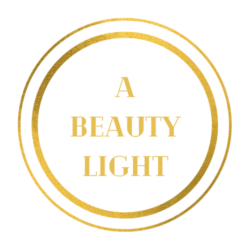This post is also available in: ![]() Svenska
Svenska
LASER HAIR REMOVAL STOCKHOLM
Laser Hair Removal - Everything You Want To Know
There are many questions about laser hair removal and here we try to answer them all! Can not find what you are looking for? Feel free to contact us for further questions!
We at A Beauty Light work with GENUINE lasers for hair removal and are located in Stockholm, Södermalm. We have both a crystal-based Alexandrite laser, DEKA Motus AX with both MOVEO technique and traditional AIR technique, as well as a Triple Diode laser equipped with all three wavelengths Alexandrite 755nm Diode 808 nm and Yag 1064 nm in the same handset. They give you the best results and are also equipped with super cooling for a basically painless treatment. We have very favorable prices, feel free to compare!
-Have you tried laser before and not been satisfied? Then you may have tried IPL and not REAL LASER! For some, even a diode laser is not enough to get rid of the hair. If you have persistent hair growth or hormonal problems, choose Alexandrite lasers. If you want the most effective laser, you should choose the crystal-based Alexandrite laser MOVEO or AIR. Assuming you meet the requirements for what can be removed by laser and you have done many treatments and did not get a good result, you should change the type of laser or choose a new therapist. Either the clinic doesn’t have a good laser, or they don’t have a laser type that suits you, or they don’t know how to use their machines, or they aren’t thorough and don’t spend the time needed to get a good result. CHANGE CLINIC!
To find out if laser is right for you, read all our information below and feel free to book a consultation. Something that is very important to know is that after they have achieved the desired effect, many people need to maintain their results with 1-2 treatments per year, while some manage for many years before they need a “Touch Up”.
Are there different types of hair lasers?
LASERs are available in several designs. Hair removal is done with a red laser. Alexandrite lasers, diode lasers and Yaglasers. (There are also Ruby lasers but they are only for minimini areas and are not used in hair removal treatments.) An Alexandrite laser is both stronger and more effective per session than other lasers. An Alexandrite laser is crystal-based and can never lose strength over the years. Diode lasers are electronics based and need to replace the laser unit periodically. The very latest diode lasers are equipped with all 3 wavelengths 755, 808 and 1064nm in one and the same handheld device, which provides excellent conditions for all skin types and hair growth.
A laser has a concentrated light that penetrates the skin with precision and effectively kills the hair follicle with minimal risk of damage. Built-in cooling systems protect the skin and reduce discomfort. A laser treatment can be felt but should not hurt. Book a consultation and we’ll tell you how we can help you, and you’ll also get to do a test treatment so you know both how the laser works and how it feels.
TWO DIFFERENT TYPES OF ALEXANDRITE LASERS
ALEXANDRITE MOVEO An Alexandrite laser with Moveo technology works directly against the skin, and in this way you lose none of the laser light when you work. With Moveo, you put serum or gel on the area and then work back and forth over the area for a while. The cooling is very strong and the treatment usualy does not hurt at all. Most often, this type of laser is considered to be the most effective laser technology for hair removal as it is both a genuine crystal-based alexandrite at the same time as the MOVEO handle is small and flexible, which makes it easy to reach even in tricky areas such as intimately on both women and men. An Alexandrite laser with Moveo technology can handle all skin types 1-6 but is most suitable for skin types 1-5. We at A Beauty Light have an Alexandrite MOVEO and recommend anyone starting their laser hair removal to choose this option.
ALEXANDRITE AIR A standard Alexandrite laser blows cold air against the skin for cooling and fires shot after shot from a distance, trying to avoid overlapping. Most lasers shoot round shots (there are a few that shoot squares). When using air cooling, it usually feels quite substantial to treat, especially intimately. With air cooling, no gel is used on the skin. A regular Alexandrite is suitable for skin types 1-4. (An Alexandrite laser equipped with extra Yag can also be used for skin types 4-6.) We at A Beauty Light have an Alexandrite AIR that is suitable for skin types 1-4. We recommend that you first do a few times with the MOVEO before possibly switching to AIR. If you are much darker in the intimate area, then MOVEO is preferable there. For men, and women for that matter, with very stubborn hair growth, AIR may be the best option.
SEVERAL DIFFERENT TYPES OF DIODE LASERS
All diode lasers shoot nanometer 808. Then there are diode lasers that also shoot nanometer 755 & 1064 so-called double lasers or triple lasers. Some older diode lasers only shoot shot by shot, but the new, more modern diode lasers also have a sweeping technology. Diode lasers often differ in both strength and cooling effect. A diode laser loses strength with use, so it is important that the clinic replaces its laser unit in time.
With a diode laser, gel is applied to the area to be treated.
Many clinics advertise that they have “the biggest prism” and it can be good when you treat a back, for example, because then it goes very quickly, but when you want to treat slightly trickier areas such as the face, elbows, knees, fingers, toes and intimate Brazilian/Hollywood, a large prism is directly unsuitable and completely impossible to access with. The vast majority of modern diode lasers are suitable for all skin types 1-6.
What is the difference between REAL laser and IPL?
IPL is a light treatment with diffused light that is sent to the skin via a lamp equipped with a filter. It is an old-fashioned treatment that can most be likened to a waxing that gives a longer effect. IPL very rarely gives a permanent result. There is also a high risk of burns and it hurts to be treated. It is often attracted with anesthetic ointments, which only increases the risk of injury. “IPL laser” does not exist, IPL is a lamp and not a laser.
Does laser hair removal hurt?
No, not with us. Our treatments are done with lasers with super cooling and are basically completely painless! When there is a lot of hair in an area, it can get a little warm and feel a little prickly. We adapt so that you don’t find it too hot or too sticky. Communication is key to getting both a good result and a good experience.
There are other genuine lasers on the market that unfortunately can still hurt quite a bit. Ask to feel how it feels before booking a treatment with someone else. All serious clinics offer you a free consultation.
-Have you tried laser before and it really HURT? Then you have 99% tried IPL and not REAL LASER!
If you have very abundant hair growth with thick dark strands, it will be a little more difficult than if you have smaller and thin light strands. Regardless, we adapt the treatment just for you.
The only time we unfortunately cannot remove hair growth without it being painful is if you want to remove the entire beard. We have to go hard to get a good result there and it usually only suits skin types 1-4.
What to think about before laser hair removal?
*Refrain from sunbathing
-You should refrain from sunbathing:
With Diodlaser 1 week before and after treatment.
With Alexandrite lasers 3-4 weeks before and after treatment.
Tanned skin reduces the effect of the treatment and increases the risk of pigment changes (however, pigment changes after treatment are very rare and are only seen in less than 1% of patients). Also, do not use tanning products. It is best if you avoid sunbathing during your entire treatment period.
*Shave before the visit
-Please refrain from shaving for a week before the visit and let the area rest to avoid irritated skin. The hair should then be shaved 24-48 hours before the treatment. Freshly shaved goes well, but a very short growth of about 1mm is the ultimate, but it must not be longer than 2mm.
*Do not wax, pluck or bleach your hair
-Do not grow, pluck or bleach your hair four weeks before your treatment. The laser only works on hair follicles that contain hair. It does not help to dye the hair to get a better result, it is the color towards and at the hair root that affects the result.
*Come freshly showered & without creams
-Come freshly showered and use NO creams, deodorants etc on the body.
How does laser hair removal work?
It is required that the hair root is heated up to 72 degrees for it to die and then not be able to let a new hair grow up. You usually count on 6-12 treatments to achieve optimal effect. The reason for this is that the laser only accesses the active hair follicles that are in the plant phase. Resting hair follicles lack hairs with pigment and are therefore not heated by the laser pulses. Hair removal can take anywhere from a few minutes to several hours depending on which body areas are being treated.
It should pass 2-12 weeks between the treatments because you have to wait until the dormant hair follicles become active again, it differs depending on where on the body the hair is removed. Some patients may find that after a few treatments they suddenly have more hair. The explanation is that the remaining dormant hair follicles are “activated” by the laser faster than they would have done without treatment. This is only positive – then we will more easily get rid of these “newly activated” hair follicles at the next treatment! Skin areas without hair or with only “scabs” should not be treated as you can instead trigger hair growth.
How is a laser hair removal treatment performed?
Before a laser treatment, you must have shaved the area beforehand. When using a Diode laser or Alexandrite laser with moveo technology, either gel or special oil is placed on the area to provide good contact and glide when the nozzle is to be moved over the skin. With regular alexandrite lasers, nothing is used on the skin as you shoot the laser at a small distance from the skin. Area by area is worked through and when it is finished, any remaining gel is wiped away. If you lasered intimately, you get some time for yourself to dry off and get dressed.
What is good to know after a hair removal treatment?
After a visit with Diodlaser, you will hardly notice that you have had a laser treatment. You may experience some skin redness. After Alexandrite, some may become a little red and a little swollen. A cooling Aloe Vera cream can then feel nice. Avoid scratching/tearing the skin if it is irritated. Avoid anything that can generate heat such as warm or hot showers, saunas or exercise for 48 hours. Also avoid swimming in the pool during this time.
One to two weeks after the treatment the hair will start to fall out, not all hair but a lot of it. 3-4 weeks after the treatment, you should notice that the hair that eventually grows out is usually thinner, softer and grows more slowly.
To minimize the risk of pigment changes on the skin after laser treatment, it is important to protect treated body parts from the sun. This applies above all to the first weeks after treatment. Immediately after a treatment, you can otherwise live as usual.
Sometimes you can get some spots after the laser, usually because the guidelines we listed above were not followed . On light skin they can be a little red and on darker skin they can look dark/black. These disappear after a few weeks, sometimes a little longer, but they disappear. In some exceptional cases, occasional water blisters are seen which disappear spontaneously within 48 hours. For more information on possible side effects, read the section on risks further down the page.
What is meant by intimate Brazilian /Hollywood/Manzillian?
It is an expression of how much hair you choose to remove intimately.
Bikini is when you remove along the bikini line so that no hair is visible when using a panty without a string.
Brazilian is when you remove almost everything both on the front and between the buttocks.
Hollywood is called when you remove just about all hair intimately.
Manzilian is a Brazilian term for men.
We remove Brazilian / Hollywood hair on both women and men. It can be difficult to find clinics that perform laser on men intimately. With us, however, everyone is welcome!
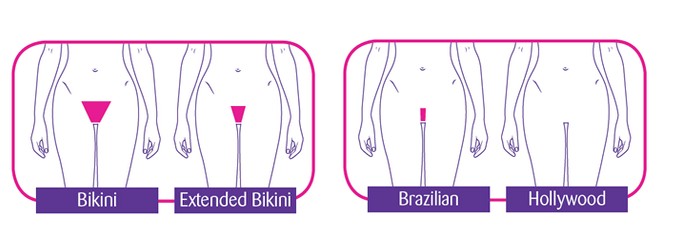
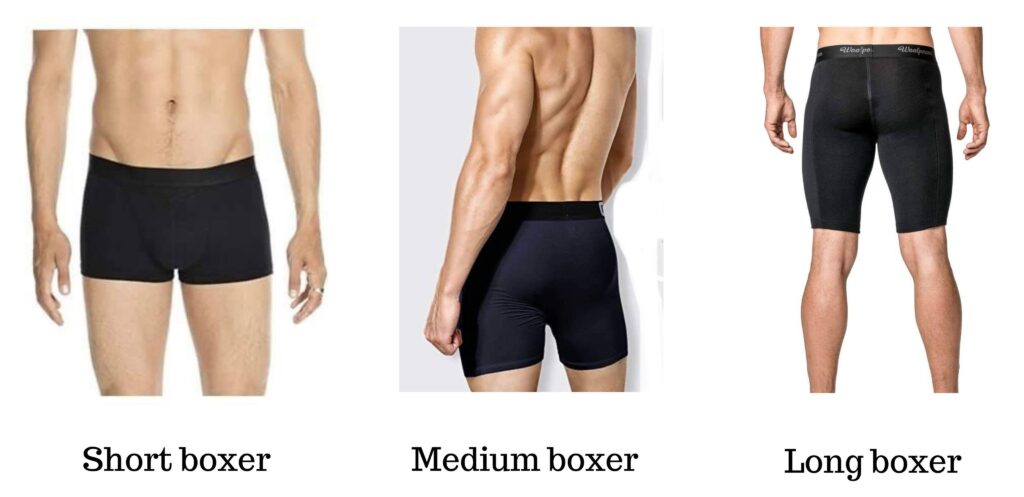
Manzillian = intimate front where you choose if you want to save a small part and between the buttocks.
Hollywood = then you remove everything intimate in the front and between the buttocks.
Short/Medium/Long boxer = we remove everything you want in this area.
How long does it take to become hairless?
The laser significantly reduces hair growth, but you will not be 100% hair-free. Most people experience that the hair disappears and that only soft hair and possibly individual hairs remain. It differs from person to person.
The conditions are different. Light skin, dark hairs are optimal on paper but there are more factors that affect. Hormones can bring dormant hair follicles to life. Some may need to “maintain” with treatments over the years to “kill” newly awakened hair follicles. A dead hair follicle is and remains dead. However, dormant hair follicles can come to life. All bodies wake up some dormant hair follicles over the years , it is affected by genetics, hormones, certain preparations and age. Something that is very important to know is that after they have achieved the desired effect, many people need to maintain their results with 1-2 treatments per year, while some manage for many years before they need a “Touch Up”.
Growth phase
Hair removal must take some time. Since we can not speed up the different growth phases, we have to adapt to the resting time of the hairs (Katagen). Only hair in the active growth phase (Anagen) can be removed. Hair removal can take anywhere between 5-18 months depending on the area being treated. Armpits and bikinis / intimate are usually easiest and fastest. The face usually requires more treatments as the hairs are a little thinner. It is also common for the face to require maintenance treatments as we have a lot of hair follicles there that can come to life. Legs and back usually take the longest time as the rest period is very long in these areas.
Laser hair removal is not a quick fix to get nice legs for spring. It takes a bit of planning but many of me think it’s worth it, but I want to emphasize that the results can vary from person to person. It is mostly about how many treatments you need to be satisfied. Some need only 4-6 treatments while others may need 10-12 treatments and some people need even moore. However, the vast majority are very satisfied and the feeling is usually; -Why did I not do this a long time ago?
Difficult/stubborn areas
Certain areas of the body are often more stubborn than others. The face, around the nipples, elbows, knees and fingers are typical ones. Intimately inside the labia and around the anus can be difficult to access. In all these cases, crystal-based alexandrite with moveo is preferable. It is both more efficient and can be accessed better as it has a different type of nozzle.
Hormones and supplements
Some people have more production of new hair follicles than others. It can be genetic but it can also be a hormonal disorder such as PCOS syndrome. Hair growth can also be affected by certain food supplements. With age, hair growth also changes, on the head and intimately it becomes less and thinner, while on the rest of the body it can increase. Women often get a little more hair, for example. upper lip and chin. Men often get hair on their noses and ears. If they haven’t had hair on their back before, it often comes with it. If you have a lot of new hair production, you may need to do maintenance treatments.
Laser doesn’t work for everyone
The basic requirement is that the hair must be darker than the skin for a laser treatment to work. This means, among other things, that it is often difficult to get good results on very dark skin types even if the hair is dark, but also on very light skin types that have very light hair.
If your hair is very light/white, gray or red, lasers will not work to remove hair. Sometimes it can happen that if your hair on the head goes in the red direction but the hair in other places looks darker than red, it may still contain the red pigment and then it will be difficult to get a result. So if you belong to those with suspicious red pigments, you should choose crystal-based alexandrite laser to begin with. If you don’t think you’re getting a result at all, you should do the diameter. If you think you are seeing results, it may be worth continuing with the laser, but it may be difficult to get a permanent result. However, many people think it is worth it even if you need to continue with maintenance treatments.
There is another parameter that affects whether the laser works on your hair growth, namely there are five types of hair. During laser hair removal, the laser energy is brought down to the hair root through the pigment strand in the hair, also called the medulla. It can look several ways.
1. Continuous medulla- The pigment strand goes all the way down to the root without interruption. These are easy to treat.
2. Interrupted medulla- The pigment strand is interrupted at regular intervals. Can be difficult to treat if no pigment is present at the root.
3. Fragmented medulla- Here the medulla is interrupted without symmetry. Can be difficult to treat if there is too little pigment near the root.
4. Solid medulla- Continuous strand of pigment that leaks into the cortex, i.e. the entire hair is pigmented. This is by far the easiest hair to treat with good results.
5. No medulla- Red, grey, white and very light hairs have no pigment strand and therefore cannot be treated with laser.
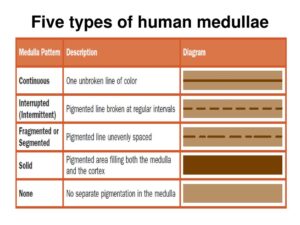
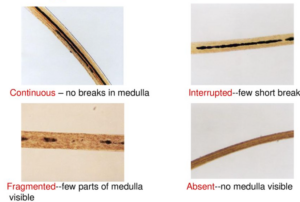
Is laser hair removal permanent?
The laser significantly reduces hair growth, but you will not be 100% hairless. The vast majority of people experience that the hair disappears and that only soft fluff and possibly occasional hairs remain. It differs from person to person.
Something that is very important to know is that after they have achieved the desired effect, many people need to maintain their results with 1-2 treatments per year, while some manage for many years before they need a “TochUp”.
So why do you read about “permanent hair removal”?
Well, the hair removal is permanent to the extent that when you damage/kill a hair follicle, that particular hair follicle will not be able to produce hair again. It is therefore a permanent injury. Many choose to use the term “permanent hair reduction” instead. It’s the same here, the damage and reduction is permanent. However, many people will have completely new hair follicles activated with age. These hair follicles lie latent in the body since birth and they are then “portioned” out of the body throughout your life. How much hair growth you have depends mainly on ethnicity but also on hormones. Hence, you will get very different answers to the question of how good the effect is and how many times others have done and how they have experienced laser hair removal.
What is a Folliculitis?
What is folliculitis?
Folliculitis is another name for hair follicle inflammation. The hair follicles are small pockets in which every hair on the body sits. The best way to avoid hair follicle inflammation is to simply laser the hair off.
Why do you get folliculitis?
Folliculitis occurs when bacteria or fungus has entered a hair follicle. This is often due to the fact that you shaved or waxed so that small injuries occurred in the skin. Ingrown hairs, hairs that grow into the skin, can also create a small opening for infectious agents to enter the hair follicle. Ingrown hairs also often occur due to shaving and waxing. Very tight clothing is another cause of ingrown hairs and folliculitis.
How to get rid of folliculitis?
Most often, hair follicle inflammation goes away on its own. You can try over-the-counter medicines at the pharmacy that you can dab on the affected area to combat bacteria. Sometimes treatment with antibiotics or antifungal agents is needed.
Can you get a folliculitis anywhere?
Yes, you can get a folliculitis in any hair follicle on the body. Most commonly, however, inflammation occurs where you shave or wax. The chest, back, shoulders, legs, arms and abdomen are therefore more often affected by folliculitis than other parts of the body.
What can I do myself?
A folliculitis often occurs due to an ingrown hair. If you squeeze or touch the area around an ingrown hair a lot, the risk of bacteria entering the hair follicle and causing an inflammation increases. Therefore, avoid doing it. At the pharmacy, you can buy a solution that counteracts bacteria that you can bathe the affected area with. If you have a lot of trouble, you also need to avoid shaving and waxing and avoid wearing tight clothes for a while.
If you remove hair with a laser, problems with hair follicle inflammation will of course decrease at the same rate as you get rid of the hair.
To reduce discomfort after shaving, it is good if you
avoid disposable razors
don’t borrow someone else’s razor
using a sharp razor
moisturizes the skin before shaving
clean the skin before shaving
use properly with shaving foam or shaving gel
gently press the razor against the skin
using aftershave products
lubricates the skin after shaving.
Cleansing your skin before shaving removes dead skin and dirt that can otherwise clog follicles and cause ingrown hairs. Aftershave products soothe the skin and prevent inflammation. After intimate shaving, there are special products you can use that are adapted to the sensitive skin in the abdomen.
What is a Pilonidal Cyst?
We can help you relieve the discomfort of pilonidal cysts by laser hair removal. Laser drastically reduces the risk of new cysts. Choose Alexandria lasers if you want to book a treatment.
A pilonidal cyst is a wart-filled abscess located in the middle of the lower back, right where the buttocks divide. The pilonidal cyst is harmless, often small and hardly noticeable, but it can also happen that it becomes infected and hurts. Then the ware may need to be drained, and if the problems return, you can choose to operate to remove the pilonidal cyst once and for all.
It is somewhat unclear how the pilonidal cyst occurs. It is probably that a hair has been pushed back into its follicle, with inflammation in the follicle as a result. The area may swell and feel tender. Sometimes the inflamed hair follicle can rupture, and then a channel is formed under the skin called a fistula. The hair follicle can also leak fluid to the outside of the skin.
Over time, more fistula passages may form under the skin. If bacteria get in, the fistula passage can become infected and a wart abscess occurs. Inflammations and boils can come and go without you yourself being active in the origin.
The pilonidal cyst is therefore not dangerous, but it can cause some problems. To avoid pilonidal cysts, or alleviate their effect, it can be good to remove the hair in the area where the pilonidal cyst is located, and keep it properly clean. It is possible to shave the area, but hair laser is preferable as it reduces the risk of new cysts.
What is PCOS and Hirsutism?
We can make it easier for both you with Hirutism and PCOS to a life with less problems with hair growth. Although it is difficult to get permanent results as hormonal disturbances cause you to produce more new hair follicles than other people, we can really make a difference. If you want to book a treatment, you should choose alexandrite lasers. If you suspect that you have PCOS or Hirutism, you should contact a doctor for an investigation. There is help to be had and knowledge makes living with PCOS and Hirutism easier.
Hirsutism means increased male-type body hair. It is a coarse and darkly pigmented hair that is typically located on the upper lip and chin, around the nipples, in the midline on the lower part of the abdomen, the back and groin and thighs, but also “male” hair loss on the head. This hair type is stimulated by androgens.
The most common cause of hirsutism is PCOS. However, about 20 percent of patients with hirsutism have completely normal androgen levels and no PCOS. Hirsutism can then be explained by an increased sensitivity to androgens in the hair follicles. Rare conditions such as hormone-producing tumor and other specific hormonal disorders can also cause hirsutism. Furthermore, certain medications such as antiepileptics, androgens and anabolic steroids can cause increased body hair.
Polycystic ovary syndrome, PCOS, is the most common hormonal disorder in women of childbearing age and is due to increased activity of testosterone. Symptoms of PCOS should be investigated with hormone tests and ultrasound of the ovaries.
Infrequent or absent periods, infertility, hirsutism and acne are symptoms that raise suspicion of PCOS.
Polycystic ovaries detected by ultrasound means ovaries with many follicles and is a common finding in PCOS.
Overweight and obesity are common in PCOS patients but also occur in normal and low weight. If overweight, weight loss is recommended, as weight loss leads to improved hormonal balance and menstrual function, reduced hair growth and increased chance of pregnancy as ovulation can spontaneously return.
Menstrual disorders and hirsutism can be treated with combined birth control pills, preferably estrogen-dominated if there are no contraindications.
In case of desire for children and disturbed ovulation, hormone treatment is given to stimulate ovulation or, if necessary, IVF. Fertility potential is usually good.
Can you try to laser before booking treatment?
Of course! It is possible to book a FREE consultation. You get a opportunity to do a test treatment so that you know both how the laser works and how it feels. Feel free to call or text and you will get answers to your questions and get to know exactly your conditions. All reputable clinics offer free consultation.
Welcome to book a free consultation with us at A Beauty Light for laser hair removal in Stockholm.
Can all be treated with our lasers?
No. There are several reasons why some people should not be treated with lasers.
White hairs do not disappear with laser. Even gray and red-blonde hair does not work with lasers. Very thin, fine hairs can also be difficult to remove, but Alexandrite usually works well here as well. The hair must contain more pigment than your skin to be removed. To remove unpigmented strands (white/light grey/red-blonde) diametri is required, i.e. a needle is used which burns each individual hair follicle separately. On the other hand, hair growth can sometimes be held back by laser treatment, but this requires continuous treatments.
If you have very dark skin or are very sunburnt, laser is not optimal even if it is possible. A rule of thumb is that there should be a clear color difference between the hairs you want to remove and the surrounding skin. With the new modern lasers such as our lasers, however, you usually get a good result even on dark skin.
Even with certain medications that, for example, make you sensitive to light and for certain diseases, treatment should not be carried out. Tertracycline, another antibiotic, cortisone and Roaccutane, are some examples. We go through this in a health declaration before your treatment.
Can you laser on a tattoo?
No. It is not possible to remove hair in places where you have a tattoo as the laser works against color and thus will damage both the skin and the tattoo.
Can you do laser treatment during pregnancy?
The laser itself cannot really do any harm, but there are no studies done and fetuses or small children cannot give their consent to studies. This is why we say no to treatment of pregnant or breastfeeding women.
Is there an age limit for laser hair removal?
We apply an age limit of 18 years. With the parent’s approval, however, treatment can also be done on minors.
Can you laser anywhere on the body?
No. We do not laser on:
– Mucous membranes ex. inside the nose
– On the head (neck and face go well)
– 2cm from the eyes (between and over eyebrows goes well)
Can you laser during menstruation?
Yes, it works well if you use a tampon or menstrual cup!
Are you exposed to radiation during hair laser treatment?
No, a hair laser works in the visible spectrum of light. It does not emit dangerous radiation. A hair laser sends a directed, focused light (energy) that is converted into heat when absorbed by the pigment in the hair shaft. A hair laser, on the other hand, if used incorrectly, can cause burns. It is extremely important that everyone staying in the treatment room uses safety glasses intended for the purpose.
Can laser damage the testicles?
No, this type of laser is not dangerous for the intimate parts and does not affect the function of the testicles.
Is laser hair removal dangerous?
If you visit a serious clinic with education and knowledge, the risks of laser hair removal are minimal. However, you should be aware that radiation from lasers can cause damage and complications if performed incorrectly alternatively, that you as a customer do not follow the recommendations about what you can and cannot do before, during and after the treatment.
- Eye injuries
During treatment, both the patient and the therapist must wear goggles adapted for the purpose. Treatment closer than 2 cm from the eyes may only be performed under the responsibility of a licensed physician. - Burns
NEVER use anesthetic ointment or similar. You must be able to feel if the therapist is using too much strength.
Burns can cause both infections and scarring. The darker your skin, the greater the risk of burns. The risk of injury can also increase if you use certain medicines or tan-without-sun products at the same time. Sometimes you can get some spots after the laser. On light skin they can be a little red and on darker skin they can look dark/black. These disappear after a few weeks, sometimes a little longer, but they disappear. In some exceptional cases, occasional water blisters are seen which disappear spontaneously within 48 hours. This is mostly avoided by following the recommendations not to expose the skin to the sun both before and after laser treatment and to avoid anything that adds heat such as exercise, sauna, hot shower etc. 48 hours after the treatment. Keep the skin well moisturized. Never scratch if the skin feels irritated. If you get a skin reaction, take an antihistamine tablet and try to keep the skin cool. - Hyper- and hypnopigmentation
Laser can cause disorders in the pigmentation, which means that the treated skin becomes darker or lighter than the surrounding skin. This is mostly avoided by following the recommendations not to expose the skin to sun both before and after laser treatment. It is also important not to laser if you are taking medicines that make you sensitive to light.The Swedish Radiation Protection Authority
Does laser hair removal really work?
Yes absolutely!
Hair laser is great but laser does not work for everyone
The basic requirement is that the hair must be darker than the skin for a laser treatment to work. This means, among other things, that it is often difficult to get good results on very dark skin types even if the hair is dark, but also on very light skin types that have very light hair.
If your hair is very light/white, gray or red, laser hair removal will not work. Sometimes it can happen that if your hair on the head goes in the red direction but the hair in other places looks darker than red, it may still contain the red pigment and then it will be difficult to get a result. So if you belong to those with suspicious red pigments, you should choose crystal-based alexandrite laser to begin with. If you don’t think you get a result at all, you should do diathermy. If you think you are seeing results, it may be worth continuing with the laser, but it may be difficult to get a permanent result. However, many people think it is worth it even if you need to continue with maintenance treatments.
There is another parameter that affects whether the laser works on your hair growth, namely there are five types of hair. During laser hair removal, the laser energy is brought down to the hair root through the pigment strand in the hair, also called the medulla. It can look several ways.
1. Continuous medulla– The pigment strand goes all the way down to the root without interruption. These are easy to treat.
2. Interrupted medulla– The pigment strand is interrupted at regular intervals. Can be difficult to treat if no pigment is present at the root.
3. Fragmented medulla– Here the medulla is interrupted without symmetry. Can be difficult to treat if there is too little pigment near the root.
4. Solid medulla– Continuous strand of pigment that leaks into the cortex, i.e. the entire hair is pigmented. This is by far the easiest hair to treat with good results.
5. No medulla– Red, grey, white and very light hairs have no pigment strand and therefore cannot be treated with laser.


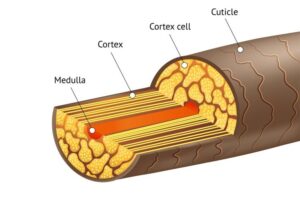
Do I have to book a consultation before booking treatment?
No, with us you don’t need that. However, we want you to carefully read through the information we have here on this page. If you have more questions, you are welcome to write to us by email, SMS, DM on Instagram, Messenger or WhatsApp and we will answer as soon as we have the opportunity. The first time you visit us, we will regardless do a quick health review and explain how hair laser works. The areas you want lasered must be shaved before the visit, so if you want to show how it looks before shaving, we ask you to show photographs, do not leave the hair on.
Of course, you are welcome to book a free consultation if you want!
What requirements are placed on the therapist / clinic?
Today, there are very few requirements and rules for cosmetic laser treatments. The market is not regulated and no permits are required. Therefore, it is extra important that you as a customer are careful and check that the therapist has the required knowledge. All reputable clinics offer a free consultation. Then you get the opportunity to both ask questions, test how the laser feels and at the same time get an idea of whether you feel safe with the clinic and the therapist. All our therapists are trained on the machines we use.
Welcome to book a free consultation with us at A Beauty Light for laser hair removal in Stockholm.
Here are some of the requirements and rules that exist today:
-Practor must comply with the Radiation Protection Act.
This means, among other things, that you must take the measures and observe the precautionary measures needed to prevent or counteract damage.
-Treatment closer than 2 cm from the eyes may only be performed under the responsibility of a licensed physician.
-The person who conducts business with a laser must be well acquainted with how the equipment is used and know the risks that the business may entail.
-When people are irradiated with a laser in connection with treatment in cosmetic activities, MTE may be exceeded for the person being treated.
-The laser must be approved and marked according to Swedish standard SS-EN 60825-1 or equivalent safety.
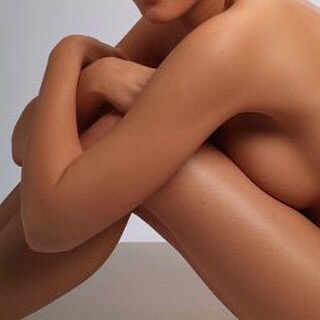
This post is also available in: ![]() Svenska
Svenska

